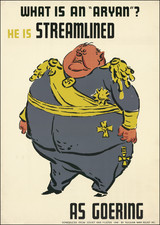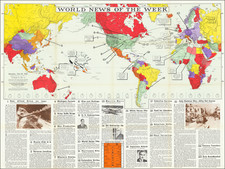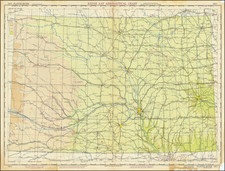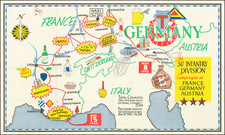The Nuclear Age began with the Trinity test at 5:30 a.m. July 16, 1945, on a stretch of New Mexico desert called Jornada del Muerto. With the detonation of “The Gadget”, an implosion-type plutonium weapon like the one later dropped on Nagasaki, the course of world history was profoundly altered.
The group of documents presented here constitutes the only substantial original record covering the Trinity test that has ever appeared for sale. The invention of the atomic bomb was perhaps the defining event of the 20th century, and certainly one of the most significant events in human history, but because of the highly secretive and dangerous nature of the Trinity test, its formal documentation in printed material was necessarily subject to censorship and sanitization. For this reason, the coherent and largely manuscript original account presented here is not just a superlative artifact of the birth of the Atomic Age, but also a vital source for future research.
This extraordinary archive, including some 250 pages of hand-written journal entries, notes, diagrams, memos, and maps, winds its way through the pivotal time before, during, and immediately following the Trinity test. It documents in rich detail the issues faced by Colonel Stafford L. Warren, M.D., the head of the Manhattan Project Medical Group, and his colleagues, as they worked under enormous pressure to ensure the safe detonation of the world’s first nuclear weapon, and then to understand and control its aftermath. The Group had enormous influence over the fundamental aspects of the test: when it would occur, how it was to be conducted, and what steps were to be taken to protect both those that participated in it and the surrounding communities.
The story of the Manhattan Project and Trinity test has been told many times. Some writers have even addressed the work of the Medical Group in depth, perhaps most notably in Ferenc Morton Szasz’ The Day the Sun Rose Twice (1984), Barton Hacker’s The Dragon’s Tail (1986), Richard Rhodes’ The Making of the Atomic Bomb (1986), and James Nolan’s Atomic Doctors (2020). However, the wealth and variety of material in this archive provides new insight into perhaps the most enduring legacy of one of the most important events in the history of man.
The Medical Group was led by doctors who, having dedicated their careers to maintaining and improving human health, found themselves advancing and covering for an enormously destructive weapons program. The tensions arising from those conflicting roles are evident throughout this archive, sometimes raised in explicit terms, sometimes barely concealed under highly technical material and data. Indeed, these tensions, between civilians and the military, between pure and applied science, and between geopolitical imperatives and the well-being of local communities, provide the essential context in which the significance of this archive becomes intelligible.
Nowhere were these conflicts more manifest than in the issue of radioactive fallout. The major players understood that Trinity would produce large amounts, but what was uncertain was where the winds would carry it, how much would fall to earth and in what concentrations, and the short-term impact of different exposure levels on human health (What was all-but unknown was the long-term impact of exposure.) As members of the Manhattan Project, subject to the strictest demands of national security, Medical Group members had to balance the need for secrecy and the need to protect nearby populations, by informing them they were at risk and, if necessary, evacuating them to safety. As these documents show, the doctors’ record in this regard was decidedly mixed.
The archive also reveals the under-funded, haphazard, and improvisational nature of the Trinity Test monitoring program. Concerns that radioactive fallout from the test might pose a lethal threat to nearby populations were first raised by Manhattan Project scientists only three months before Trinity. Still more troubling, the fallout monitoring program that was finally enacted was not approved by General Leslie Groves (the Manhattan Project’s operational lead) until only nine days before the test. The frantic character of the operation is revealed, for example, in Victor Weisskopf ’s hastily scrawled pencil calculations for the likely decay rate of the radioactive fallout, done several hours after the test itself, (#79847 and #79848); Stafford Warren’s frantic journal entries as his teams raced to follow the mushroom cloud after Zero Hour (#79843, #79844); and Joe Hoffman’s use of a Phillips 66 gas station map of New Mexico to record radiation readings (#80001).
For decades, this archive was buried in military archives, uncataloged and unknown to historians, even after it was declassified in the 1960s. Evidently, it became an afterthought, for it somehow made its way to Lowry Air Force Base in Colorado, where it remained until 1995. Then, during the wave of U.S. base closings in the post-Cold War era, it was sold off during Lowry’s decommissioning and purchased by a private collector. who retained it until we acquired the archive in late 2021.
Contents of the Archive
The archive comprises 275 pages of material including printed memoranda, many of which are annotated by Warren; hand-written notes, diagrams, sketches, and tables; Warren’s diary, in his own hand, recording the events of the test in real time; and thirteen large-scale maps and diagrams, most printed but bearing extensive and very significant manuscript annotations. Some of the material is bureaucratic and formal, but much is extemporaneous and rushed.
The material has been collated into three groups: material from before the test (April 12-July 15, 1945); material from the day of the test (July 16); and material from the following days, weeks, and months (July 17, 1945-March 9, 1946). In addition, large maps and diagrams are catalogued separately. All material included in the archive has been digitized and briefly described. Each description includes a date or approximate date. Throughout this description of the archive, we refer to many of the most important pieces of the archive, with their stock number for reference.
The contents of the archive are as follows:
Planning for Trinity: April 12-July 15, 1945
119 pages; including 46 pages of printed memos (many with additions in manuscript), including a few duplicates and triplicates. The rest comprises manuscript notes, sketches, and printed graphs.
Day of Trinity: July 16th, 1945
39 pages; of which the vast majority is handwritten notes and sketches. Official memos compose a minor component of this part of the archive. The highlight of this section is Warren’s minute-by-minute diary of the test (#79842-79844), which will be discussed
below.
The Fallout: July 17th, 1945 to March 9, 1946
103 pages; which is partitioned between printed memos, notes, and sketch maps. The material includes “in-the-moment” reports of the teams of roving monitors that inspected the New Mexico desert for fallout after Trinity; calculations related to the planned drop of the “Little Boy” bomb on Japan; and Warren’s draft of a remarkable memo ultimately sent to General Groves, titled “Use of the Gadget as an Assault Weapon” (# 79916).
Maps and Diagrams
Fourteen larger-than-A4 sheets are included in the archive. These include printed maps with substantial annotations, sketch maps, a large sketch of a mushroom cloud, and a newspaper clipping. The maps show features including the extent of monitoring, predictions for the Test, and isodose curves for the state.
Two of the maps are of fundamental importance to the archive. One is a massive folding map showing the direction of the radioactive mushroom cloud in the immediate aftermath of the
detonation (# 79990, illustrated pp. 24-25), while the other is the aforementioned “Hoffman Master Map” (# 80001, illustrated pp. 13 and 15) which was commenced on the 16th and updated through the 18th. This later map shows the path of this cloud in real time over several days, and tracks monitors who were deployed around New Mexico to measure radiation levels.
Final Thoughts
The Trinity test was conducted by some of the greatest minds of the 20th century - scientists who valued empiricism and data-based decision making, and military men and bureaucrats for whom documentation and memo-writing were the foundation of any large-scale organization. As such, a large contemporary written record was produced for Trinity. However, for almost eight decades, that record was missing one of its cornerstones, hundreds of pages of documents assembled by the head of the Manhattan Project Medical Group before, during, and after the test itself.
While significant collections of printed reports and memos reside in select national repositories, the importance of a coherent collection of primary manuscript documents for an event such as the Trinity test cannot be overstated. The present archive lays bare one of the critical moments in the history of World War II, the United States, and indeed humanity itself. Through it we can see, without censorship and sanitization, the real-time reactions of those who first and most closely grappled with the dangerous reality of nuclear weapons.
These documents make clear, among many things, what the U.S. government knew about the Trinity test and its fallout, and when they knew it. Through these papers, the ethical questions raised by the atomic bomb, and the participation of doctors and scientists in its development and use, are shown in stark relief.
Such a comprehensive collection of original documents related to the birth of the atomic bomb has not been offered for sale before and likely will never be offered again. Thus, this is a unique opportunity for a collector or institution to secure a peerless record of a pivotal moment in human history.
Note: This archive was owned jointly with Boston Rare Maps. The unabridged description was published as "Zero Hour: Documenting the Dawn of the Nuclear Age". PDF copies of that catalog are available upon request.









![Gibraltar to Berlin. [World War II Broadside Map.]](https://storage.googleapis.com/raremaps/img/small/83480.jpg)




